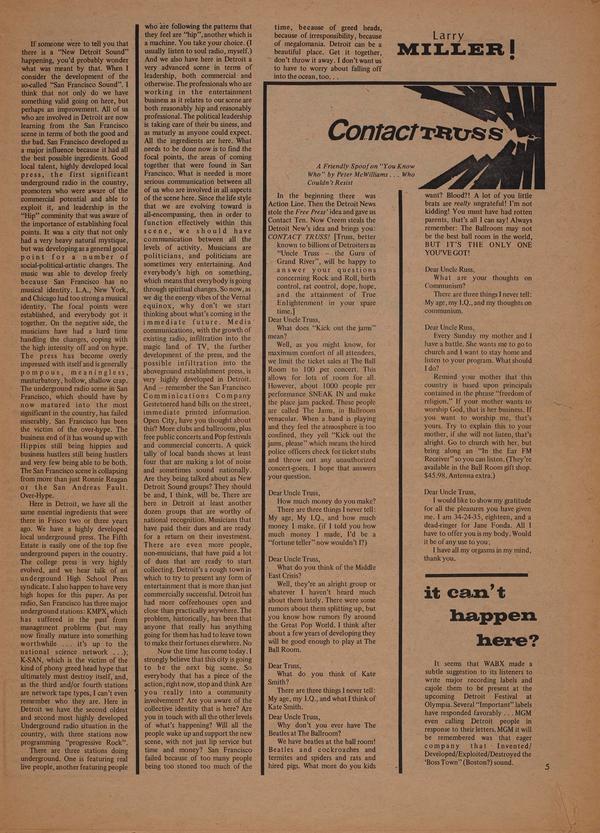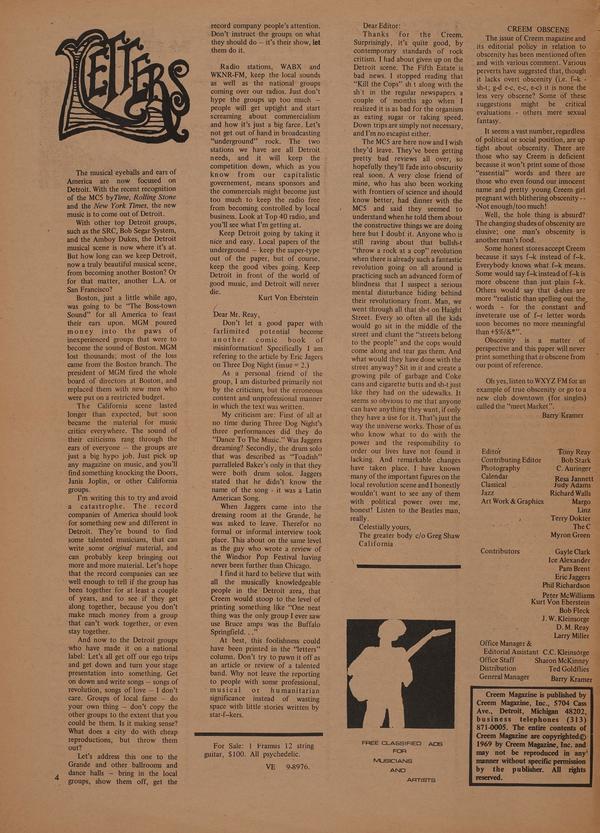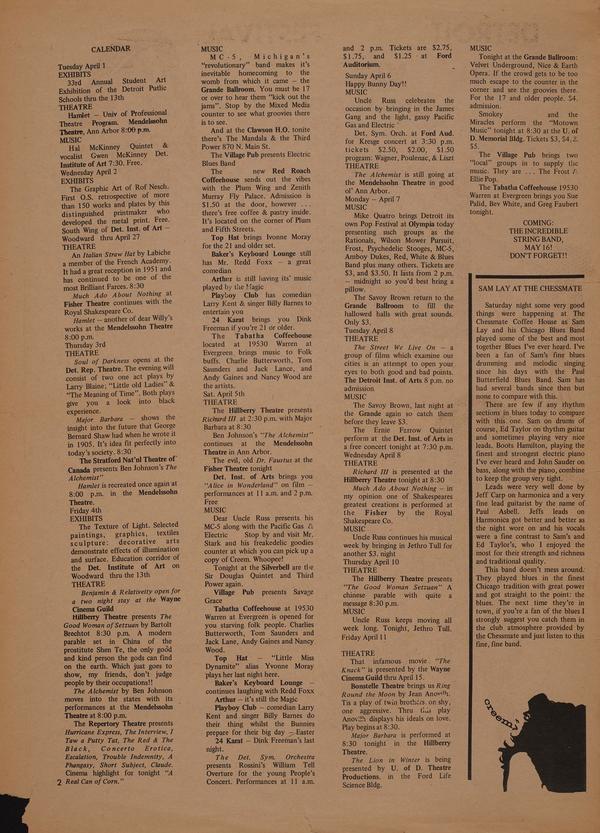RICHARD WALLS
When I told a friend of mine I was gping to write an article on Brubeck, he recommended I “be brutal.” Tempting advice ... Brubeck’s music is so inconsequential and he sells so many records. But one must be fair and keep in mind Brubeck’s musical limitations.


The CREEM Archive presents the magazine as originally created. Digital text has been scanned from its original print format and may contain formatting quirks and inconsistencies.
RICHARD WALLS
THROUGH TIME AND SPACE WITH DAVE BRUBECK Richard C. Walls
When I told a friend of mine I was gping to write an article on Brubeck, he recommended I “be brutal.” Tempting advice ... Brubeck’s music is so inconsequential and he sells so many records. But one must be fair and keep in mind Brubeck’s musical limitations. Keep it down to a quiet savage cut.
! Time Out (CS 8192) is the very first jazz record I bought, and, according to the sales chart, the only jazz record a lot of other people bought. But taming the warm pulsating amorphorous mass mess of my nostalgia with the cold sure hand of acquired knowledge, I find little to recommend this record. Brubeck, who is a thoroughly Western musician, i.e. who has trouble letting the music flow and relies heavily on forms, i.e. who has trouble Giving It Up (the energy flow), further stifles his basic concept by adding “unusual” time signatures: The “classic” on the album is “Take Five” which everybody loves and which is in 5/4 time, a rhythm with enough herk in it to be popular. Brubeck doesn’t solo because he has yet to learn to cope with the 5/4 bit. However, there is a drum solo that is a bit strange and, I believe, reflects Joe Mirello’s peculiar sense of humor. The rest of the songs have nice melodies but they cdon’t go anywhere. After the basiling, Crashing melody of “Blue Rondo a la Turk” the solos are characteristically restrained. “Three To Get Ready” manages to flow rather well while alternating 3/4 and 4/4 time but, as in the rest of the album, all feeling is very. .refined. If you are going to have tight restrictions then you could derive beauty from the struggle the contrast — between getting out what you feel, and the restrictions holding you in. Dig Coltrane with Miles.
The next album in the series is “Time Further Out” (CS 8490). . which Is also more form than content. For example — on the cover of the album is a painting by Joan Miro — an abstract painting around which the music is supposed to center — in fact the album is subtitled “Miro Reflections”. But the only tangible connection between the painting and the music inside is that certain number which appear in the painting suggested certain time signatures to Brubeck. Weird. And in the liner notes Brubeck says, “I feel that in Miro’s painting he has expressed in visual terms my own approach to music — that is, a search for something, new within old forms, an unexpected perspective, a surprising order and inner balance that belies the' spontaneity of compositon.” It’s this sort of rap that has helped ake Brubeck popular — the pseudo-hip “jazz is interrelated with all daring new concepts in Western art” spiel. But look at the music on the album. “Charles Matthew Helleluyah”, “Unsquare Dance”, and Buis Boogie Woogie” are all under three minutes
long — just long enough to state the theme a few times and then split. “Far More Drums” is a very straight forward 5/4 drum solo, nothing “surprising” or “unexpected”. “Far More Blues”, “Maori Blues”, and “Blues Shadows In The Street” are all (are you ready?) blues — and despite the time signatures (5/4,6/4, and 9/8 respectively) they are all . stan dar d Brube c.k funk. Heavy-handed, “Bluette” 1 i| the Brubeck staple — piece with classical overtures. The remaining cut “It’s a Raggy Waltz” is the best on the album, not because of the time signature (3/4), or it’s relation to Miro’s painting, but becauseof a nice smooth solo by alto saxophonist Paul Desmond, who seems to have an affinity for waltzes. The point of all this is that ol’ Dave should have been more humble .,. should have dropped the extra musical trappings, the technical raps^the hip references , to classical music and modern art. The music simply doesn’t live up the hype.
Next came “Countdown — Time In Outer Space” (C58575). The formula is repeated — this time a Franny Kline abstraction is on the cover, though no effort is made to relate it to the music. The liner notes contain another long Brubeck essay on time signatures, etc., all much, more lofty in tune than the eleven rather pleasant simple songs found on the album. No particular cut stands out. Desmond is fine but he isn’t given a chance to really get into anything (the, cuts average around 3 mins.) On the back of the album, beneath the listing of the tunes, we find that “The album is dedicated to Lieut. Col. John H. Glenn, Jr.”. Far Out.
The final album in the series is “Time Changes” (CS8927). On the first side of the album are five' “timely” numbers, in which nothing particularly interesting occurs except on “Unisphere” — the counterpoint between Brubeck and Desmond being rather refreshing compared with Brubeck’s ponderous solos ort the other songs. On the second side is a 16 min. 40 sec. piece called “Elementals”, performed by The Dave Brubeck Quartet with Orchestra. This musical hybrid doesn’t make it in either the classical or jazz idiom. Taken on its own, /Which is the only way to take it, the whole piece sounds like an elaborate introduction to a statement that 1 never transpires.
Now that wasn’t really very brutal. In fact, to be fair I will mention an album of Brubecks that I can recommend with only a minimum of hesitation. ‘*The Dave Brubeck Quartet at Carnegie Hall” (C2S-836), recorded Feb. 22,1963. It is a two record set and to my ear the definitive Brubeck recording. The worst (e.g. Brubeck’s funky honky solors on “St. Louis Blues” and “Southern Scence”) and the best (e.g. Desmond’s solos on “Eleven-Four” and “Blue Rondo A La Turk”). Listen to this one it’s not so bad. Arid forget about that time stuff.
MILT JACKSON
I thought Milt Jackson had learned his lesson in the mid-Fifties when he, as a member of the Modern Jazz Quartet, was involved in a lot of experimentation with the conscious hybridization of jazz and" European classical approaches, from which nothing of enduring musical Value resulted. Nonetheless, here he;is with another LP using a string quartet,, and it demonstrates the same shortcomings the old MJQ albums did. Tom McIntosh’s arrangements' are even more clumsy and plodding than JohnLewis’on; the Third Stream Music LP; the string players have, no grasp of the jazz idiom; in fact, they often have a hard time simply keeping the bea£
... well, let’s just say that the Strings are a complete failure, and go on to more interesting things.
Jackson himself, for instance. He’s one of the finest vibraharp players around, and his-work here is consistently superb. Unfortunately, most Of the album is done in a jazz style fifteen years old, and tends to sound dated, almost corny sometimes. Despite this, there is a very/ high degree of musicianship evident, though, true, in an extremely mainstream vein.
Arid there arc exceptions. “You Got to Pay When the Deal Goes' Down” is a really nice, soft, rockr type'of thing-even the strings wqrk out well. It’s by far the most interesting put on the album, and well Worth listening td several times. “The Morning After” is also rather pleasant, arid of course “New Rhumba”, an Ahmed Jamel tunc, the MilesDavis recording of which UTan Old favorite of mine. .
Excepting1; the stringsthen, a very well done, very musical album. I’m sorry to ^say, however, that most of what they’re doing so well here simply isn’t of much interest anymore.
Ramsey Lewis Mother Nature’s Son Cadet LPS-821 Richard Walls
Ramsey Lewis: piano and electric piano
Orchestra arranged and conducted by Charles Stepney
All other musicians mercifully unlisted.
Lewis has developed to the point where he projects his music with a wall of sound — unfortunately , the wall is between him and any kind of feeling. This music is bullshit. Lesis’ playing is unimaginative, uninspired, and uninteresting. Some of the arrangements are nice, but are ruined as soon as Ramsey starts playing. This is whisky jazz — get tanked out of your mind and scream curses at the world while its playing. Drown it out.
Charles Tyler Eastern Man Alone E.S.P. 1059
Charles Tyler, alto saxophone; Dave Baker, cello; Brent McKesson, Kent Brinkley, basses.
Cha-Lacy's Out East Tyler’s tone is bittersweet. Points of reference: he occasionally bounces like Ornette Coleman and occasionally sounds like Albert Ayler (those wide open low notes). But more lyrical than Ornette, less crazy than Ayler. This is not exciting music in the sense of urgency — it does, not necessarily push you in one direction or another. It sounds very fresh though, mainly because of the unusual instrumentation and Baker’s cello solos. Which are definitely out of . sight (I removed the speakers and put one up to each ear ... h m m m K m) On this tune Baker plays little dance-like figures While the two bassist maintain a steady medium up tempo meter. All the solos are themeaiic, i. e.v stretching the melody, playing with a phrase * a general free association discourse on the original statement.
Man Alone — The melody here; takes me back, to Ayler’s “The Wizard”. What Leroi Jevesreferedto as churchified chuckle tunes”. Tyler is a little more frantic (or, if you’re in a different mood, you could say positive) and the pulse is more flexible; Could all this abject . -wordage persuade you to buy this record? Jt’s really the most immediately likable E.X.P. record . I’ve ever heard — soothing and happy, a good sound to envelope the room in, , when you’re lazy with candlelight.
Le-Roi - begins with Bakers arco cello and Tyler’s alto in unison — transcendental sadness — such beauty! The basses seem superflous. Then the melody is taken up in tempo and we go back to the groove established on side one. Baker is in a mad gypsy mood—the beauty of the cello is subtle and it is hard to distill it into words without being pedantic ... five stars arid all that.
Eastern — by now we are fully in touch with the soft center of this music. Man alone, the soft center of the universe .. ."the soft center of feeling. This is more shapeless than the other tunes, goingiorward more with momentum than meter. Eastern, perhaps. Listen to the dialogue of these four men, alone together.
Richard C. Walls
THE FROST
•Side One: Jennie Lee, The Family, Long Way Down From Mobile, Take My Hand, Mystery Man.
Side Two: Baby Once You Got It, Stand In The Shadow, Little Suzie Singer, The First Day of May, Who Are You?
To most of the people who will read this review the Frost will not be a new sound. You’ve been watching them at local ‘hops’ for years. This is their first album and it’s released on Vanguard.
Out-of the 10 cuts, you have probably already heard six of them incessantly. The Frost have been playing these six songs for a long time but the other four - Long Way Down from Mobile; Jennie Lee; Little Suzie Singer; and First Day in May, are new or relatively so.
Jennie Lee opens Side one. An up tempo number - clearly written by Wily Wagner and his crew.
The Family is the next cut. I’ve been listening to this song for about 10 months now - both live and on an acetate of the group made about a year ago. Another fairly speedy number the song tells of a family and itvs troubles (oddly enough very similar to the life-lines of one of the group members). The only fault I can find, apart from the recording -which I shall say more about lateris the 4 'line opening which is somewhat of a drag after the 3rd time. I usually skip it.
‘Long Way Down from Mobile’ is another'of those Frost songs which 1 (arid iriany others) just curl up and cringe at every time it’s played. It’s so damned beautiful but so equally savagely true (after the fashionof McArtney’s “She Leaving Home’’) “Take my" Hand” arid ‘‘Mystery Man” are normally played, live, as one coritiinuous song. On the album they are split probably _ because Mystery Man is the A side of the Frost’s single. Both are extremely good songs particularly the latter which will be a smash. If it gets played and listened to.
Side Two opens with the vintage “Baby Once You’ve Got It” which has been warming up audiences at local dances for quite some time. If I could hear the rhythm guitar (that I know should be,on this and every other cut) then I would fin the tune somewhere up to par with the live performance. On the album it most certainly isn’t. Nor, for that matter, is “Stand in The Shadow”, the next cut arid also the ‘B’ side of the single. “Little Suzie Singer” is kind of a doohickywashbash zing dan doo type of ditty performed to a mutant blues best with kazoos and just about anything else you can name including some muffled mutterings. As I’venever seen this number live I can only say that it’s a happy little tune somewhat akin to what the Byrds (I mean the Byrds) would have done to Robin Williamson’s “Whistle Tune”.
‘Lucy in the Sky with Diamonds* or ‘First Day in May* as the Frost call it is not technically anything like the Beatles song, if anything then the general format is nearer “A Day in the Life” but the feeling it exhudes is the same kind of ethereal, whispishness that ‘Lucy’ has. ‘Who Are You’ is another Frost standard -the nearest to jazz that they have done in so much as it has the jerking
rhythm patterns that Brubeck might have used only of course much louder than Brubeck would have played them.
However, although my criticisms of the album are many, very little of the fault lies with the group. Now the album I am reviewing is only a dub taken from the master and warped like hell, but I’m told that this is riot the final mix. If this album is taken and re-mixed well, before release, then my'complaint with said album is practically nil. However, if this is themix that Vanguard releases, then heads will roll and the first four will be those of the band. I mean there is no stereo - no rhythm guitar - the production is the wrost I have ever heard. So bad that the whole point of combining Wagners poignant lyrics with a hard, tight band is defeated. Come on whoever you are, get it together quickly, do it to it very quickly and give the group some of the credit due to it.
I was asked to write a poem about Records. However/1 do not write poetry about records, I write them about My Love (there’s more money in it.) I will write a poem comparing my love to a record:
FOR THE RECORD:
MY LOVE.
Records are round & plastic
& have a hole in each side, much like My Love.
You can find all kind of things on records and
ybu Can find all kinds of things on My Love.
You have to turn On the phonograph and put the needle on the record before it will play right. Likewise, you have to put the needle in My Love to turn her on before she will play right.
Records never break and
My Love is never broke.
Records sound different when you
change the speed
and
My Love sounds different when you change her speed.




